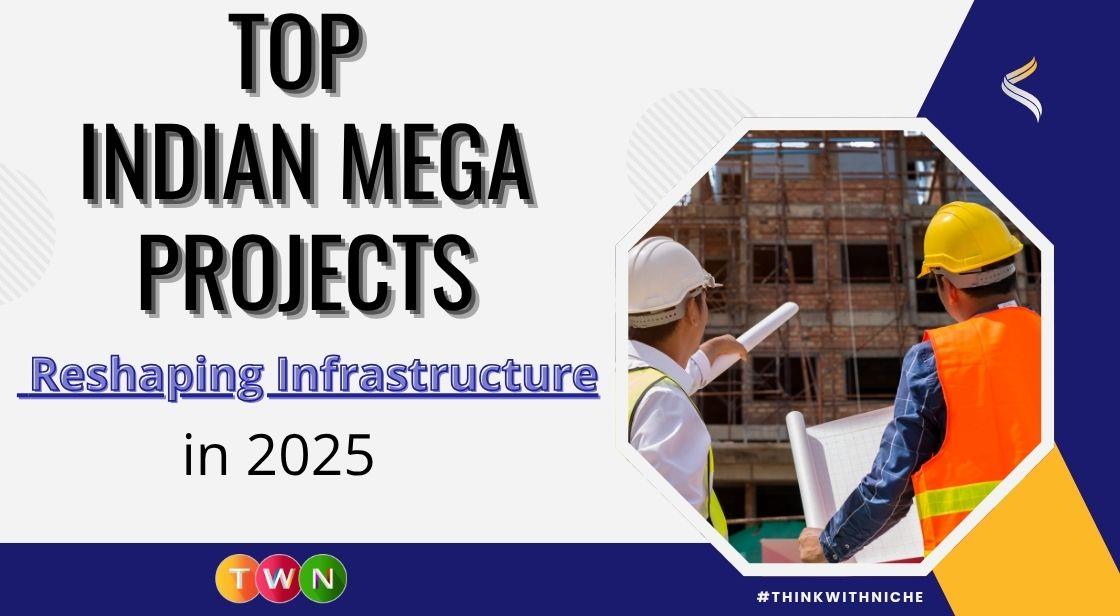Top Indian Mega Projects Reshaping Infrastructure in 2025

Podcast
Post Highlight
In 2025, India stands at the forefront of a monumental infrastructure revolution—an era marked by strategic mega projects that are reshaping the nation’s economic landscape.
From state-of-the-art expressways and high-speed rail networks to the world’s largest renewable energy park and deep-sea ports, the country is making unprecedented strides in connectivity, sustainability, and industrialisation.
Driven by visionary government initiatives like the PM Gati Shakti Master Plan and backed by large-scale public and private investments, India’s infrastructure push is laying the foundation for a $5 trillion economy.
These developments are not isolated efforts but part of a coordinated national vision to reduce logistics costs, enhance regional connectivity, boost clean energy, and attract global manufacturing.
This blog explores the 10 most transformative infrastructure projects redefining India in 2025.
Whether you're an investor, policy observer, or citizen tracking the nation’s growth trajectory, these projects highlight how India is building a more connected, competitive, and resilient future.
Popular Post
Continue Reading..
The Biggest Infrastructure Developments Across India in 2025
India is undergoing a remarkable infrastructure transformation, achieving engineering milestones while establishing its position as a global leader in sustainable, integrated development.
From vast solar parks in the desert to digital highways powering a future-ready economy, these large-scale infrastructure projects are more than development initiatives—they are the cornerstones of a modern, resilient India.
These transformative efforts aim to reduce logistics costs, support rapid urbanisation, attract global investment, and align with the country’s climate objectives.
Let’s explore 10 of the most ambitious and impactful mega projects that are redefining India's infrastructure in 2025.
1. NICDC Industrial Corridors and Smart Cities
The National Industrial Corridor Development Corporation (NICDC) is leading one of India's largest infrastructure overhauls by developing industrial corridors and smart cities. Currently, 11 such corridors are under development, encompassing over 32 nodes across the country.
These corridors are designed to:
-
Position India as a global manufacturing hub
-
Enable seamless logistics and supply chain efficiency
-
Provide plug-and-play infrastructure with high-tech urban planning
In addition, 12 smart city projects under NICDC have received an allocation of over ₹28,602 crore. These cities are envisioned as innovation-driven economic engines fostering job creation, technology transfer, high-value manufacturing, and MSME development.
2. PM Gati Shakti National Master Plan
Launched in 2021, the PM Gati Shakti Master Plan is a first-of-its-kind digital infrastructure coordination platform involving 44 central ministries and departments, along with all states and union territories.
Key features:
-
Integration of over 1,650 data layers across sectors
-
Coordination between 8 infrastructure ministries and 15 social sector ministries
-
Real-time project tracking to reduce bottlenecks and delays
Gati Shakti enables synchronised development of roads, railways, ports, and utilities, optimising costs and accelerating project delivery. It promotes multi-modal connectivity and infrastructure synergy, essential for reducing logistics costs and improving economic efficiency.
3. Bharatmala Pariyojana
Initiated in 2017, the Bharatmala Pariyojana is one of India's most expansive highway development programmes. In its first phase (2017–2022), the project targeted the construction of 34,800 km of national highways.
As of 2024:
-
₹4.72 lakh crore invested by the National Highways Authority of India (NHAI)
-
19,826 km of highways completed
The initiative aims to facilitate efficient freight movement and better connectivity through economic corridors, border roads, and logistics hubs, thereby generating employment and enhancing rural-urban integration.
4. Digital Highways Initiative
The Digital Highways Initiative by NHAI is modernising India’s transport and telecom infrastructure simultaneously. The initiative aims to lay 10,000 km of optical fibre cable infrastructure along national highways.
Highlights include:
-
Pilot corridors: 1,367 km (Delhi-Mumbai Expressway) and 512 km (Hyderabad-Bengaluru)
-
Dedicated 3-meter-wide utility corridors for fibre optics
-
Future readiness for connected vehicles, 5G/6G technologies, and smart traffic systems
This project is key to ensuring digital equity and powering India’s emerging digital economy.
5. Western Dedicated Freight Corridor (WDFC)
Part of the broader Dedicated Freight Corridor (DFC) initiative, the Western Dedicated Freight Corridor stretches 1,506 km from Dadri (Uttar Pradesh) to Jawaharlal Nehru Port (Maharashtra).
Benefits:
-
Dedicated rail line exclusively for freight movement
-
Decongestion of passenger rail services
-
Faster, energy-efficient goods transportation
As of May 2025, the corridor is 96.4% operational, providing a major boost to manufacturing, trade logistics, and port connectivity.
6. Delhi-Mumbai Expressway: Transforming India’s Road Connectivity
India’s Longest and Most Ambitious Highway
Spanning 1,386 kilometers, the Delhi-Mumbai Expressway is set to become one of the country’s most important expressway projects. Designed as an eight-lane, access-controlled corridor, it connects the national capital, Delhi, with Mumbai—India’s financial hub.
Massive Impact on Travel and Logistics
Once fully operational by October 2025, the expressway is expected to cut travel time by nearly 50%, reducing the journey from 24 hours to about 12 hours. This will significantly boost freight efficiency and lower logistics costs across key economic zones.
Smart and Sustainable Features
The expressway incorporates smart road technologies like automated toll collection (e-tolling), real-time traffic monitoring, and wildlife overpasses to ensure ecological sustainability. It also passes through multiple states, unlocking economic growth along the corridor by promoting trade, industrial clusters, and real estate development.
7. Next-Gen Airport Projects Powering India’s Aviation Future
India’s aviation sector is undergoing a significant transformation, fueled by infrastructure expansion and forward-looking policies such as the UDAN scheme and the Bharatiya Vayuyan Adhiniyam 2024.
1. Noida International Airport (Jewar)
Strategically located in Uttar Pradesh, the Noida International Airport is poised to become a key aviation hub for northern India. With validation flights currently underway, the airport is expected to begin commercial operations by the end of 2025. It will play a crucial role in reducing congestion at the Indira Gandhi International Airport in Delhi.
2. Navi Mumbai International Airport (NMI)
Situated to meet growing demand in western India, the Navi Mumbai International Airport is set to commence operations by August 2025. It will ease traffic at the Mumbai airport and support the city’s growth as a global economic centre.
Key Benefits
These projects aim to enhance regional connectivity, cater to Tier-2 and Tier-3 cities, and position India as a major global aviation hub.
8. Khavda Renewable Energy Park: Powering India's Clean Energy Future
World’s Largest Solar Park Takes Shape in Gujarat
The Khavda Renewable Energy Park, currently under development in the Kutch district of Gujarat, is poised to become the largest solar energy project in the world. Spanning an enormous area of 72,600 hectares, the park is being developed by NHPC Limited, a leading player in India’s renewable energy sector.
Massive Energy Output and Strategic Importance
Once fully operational, the park is expected to generate approximately 473 million units of electricity annually, contributing significantly to India’s growing power demands through sustainable sources. This initiative marks a critical step in India's push to decarbonize its energy mix.
Key Objectives and National Goals
The Khavda project is strategically aligned with India’s climate commitments and green energy goals. Its key objectives include:
-
Accelerating the clean energy transition
-
Supporting the national target of achieving 500 GW of non-fossil fuel-based capacity by 2030
-
Reducing long-term reliance on thermal power sources
Commissioning Timeline
The park is slated for commissioning by late 2025, and upon completion, will stand as a global symbol of India’s leadership in renewable infrastructure and climate responsibility.
9. High-Speed Rail (Bullet Train) Projects
India’s First Bullet Train Corridor: Mumbai to Ahmedabad
India is building its inaugural High-Speed Rail (HSR) corridor between Mumbai and Ahmedabad—a bold leap toward modernising the nation's rail infrastructure. Spanning 508 km, this route will enable trains to travel at speeds of over 320 km/h, reducing the current travel time of over 7 hours to approximately 2 hours.
A Japan-India Collaboration
This transformative project is being developed in technical and financial partnership with Japan, supported by the Japan International Cooperation Agency (JICA). The total estimated investment stands at ₹1.08 lakh crore, underscoring the scale and ambition of the initiative.
More Bullet Corridors on the Horizon
The Mumbai-Ahmedabad corridor is just the beginning. Additional routes, including Delhi-Ahmedabad, Delhi-Varanasi, and Varanasi-Howrah, are currently under feasibility study, marking the start of a nationwide high-speed rail ecosystem.
Benefits Beyond Speed
The HSR project is expected to bring a host of benefits:
-
Revolutionise intercity travel with faster, safer, and greener alternatives
-
Ease pressure on roads and air routes
-
Foster regional economic development and job creation
Once operational, the bullet train will redefine how India travels and stands as a symbol of the country's technological and infrastructural advancement.
10. Vadhavan Port: India’s Deep-Sea Gateway to Global Trade
A Strategic Maritime Mega Project
Approved in 2024, the Vadhavan Port in Maharashtra is set to emerge as one of India’s most significant maritime infrastructure projects. Designed to be a deep-water, all-weather port, it will feature draft depths exceeding 20 metres, allowing it to handle ultra-large container vessels that are crucial for international trade routes.
Investment and Scale
The project comes with a massive investment outlay of ₹76,200 crore and is scheduled for completion by 2030. Developed under the guidance of the Ministry of Ports, Shipping and Waterways, Vadhavan Port is expected to significantly enhance India’s cargo handling capacity, especially for transshipment and long-haul global trade.
Integrated Logistics and Connectivity
Vadhavan Port is not a standalone project. It is designed to be seamlessly integrated with the PM Gati Shakti Master Plan, national expressways, and dedicated freight corridors. This multi-modal connectivity will ensure smoother cargo movement across the hinterland and drastically reduce logistics costs.
Paving the Way for Maritime Dominance
With its advanced capabilities and strategic location, Vadhavan Port is poised to become a cornerstone of India's maritime ambitions. It will play a pivotal role in boosting exports, supporting the Make in India initiative, and establishing India as a key logistics and shipping hub in the Indo-Pacific region.
Conclusion: A Front-Row Seat to India's Infrastructure Revolution
India’s mega infrastructure projects are a testament to the country’s commitment to building a sustainable, connected, and economically vibrant future. These integrated initiatives are designed not only for development but also to serve as engines of inclusive growth, digital transformation, and environmental stewardship.
For investors, entrepreneurs, and global partners, India's infrastructure push offers a front-row seat to one of the largest and most strategic economic transformations of the 21st century.
Stay informed and explore opportunities across sectors like aviation, construction, logistics, ports, railways, and highways to be a part of India’s growth story.








